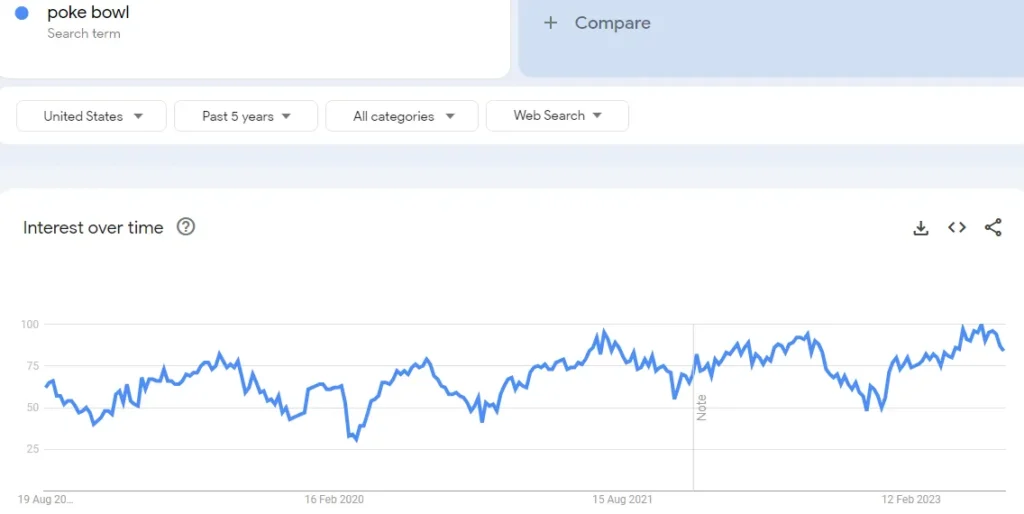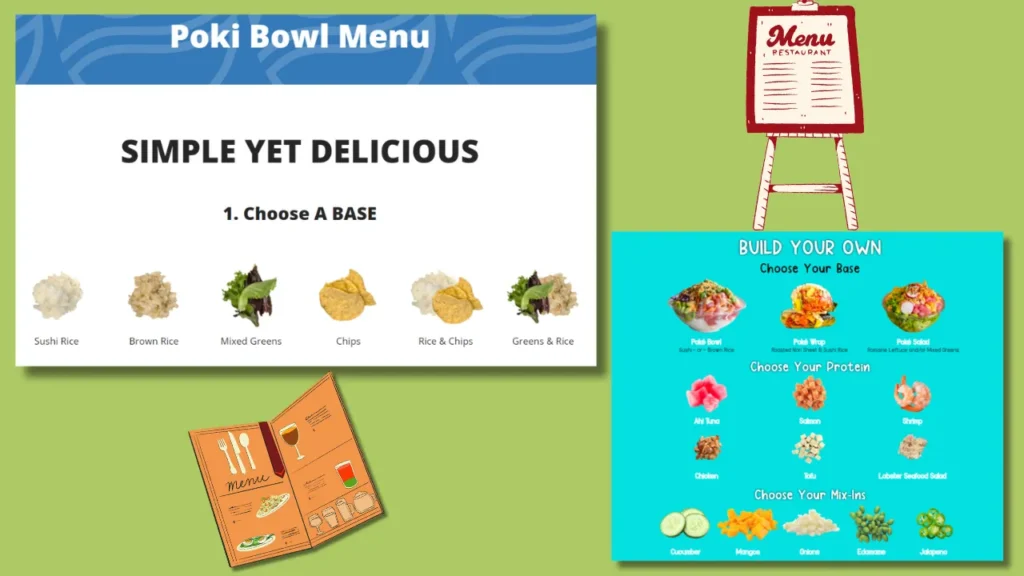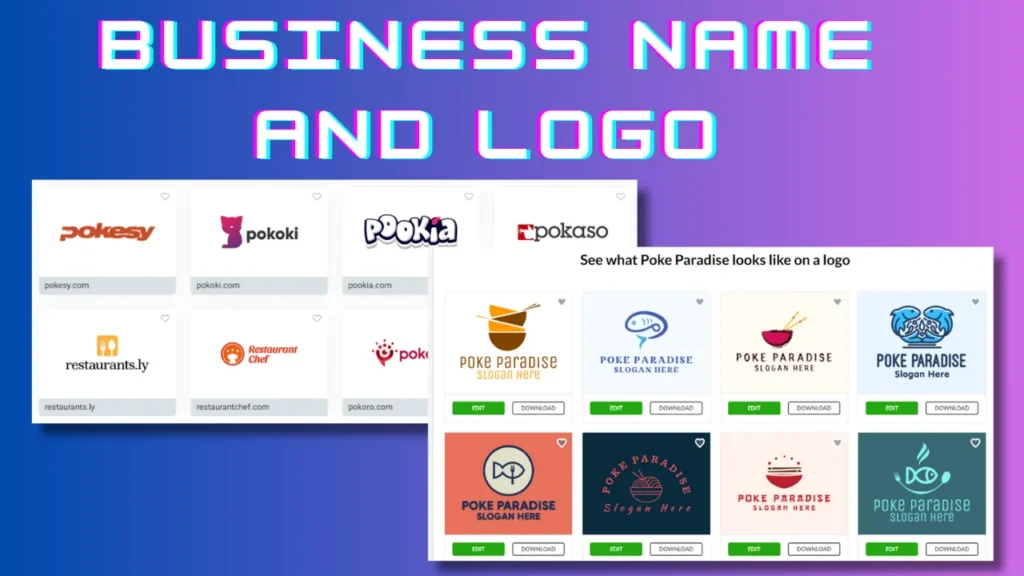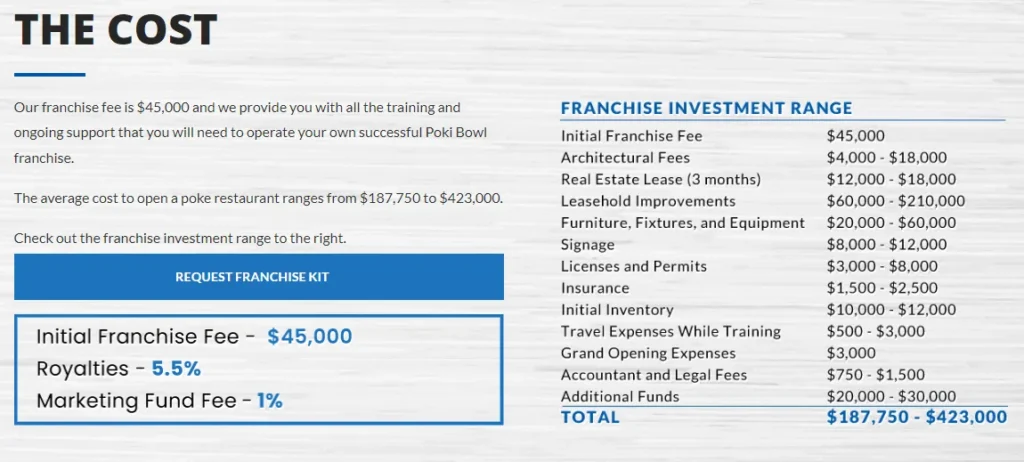Have you ever wanted to make a healthy poke bowl? Have you ever thought about starting a business in the growing health-consciousness industry? This is the right time to get into it.
Starting a poke bowl business can be a profitable idea to turn your passion and interest.
Unlike traditional fast food, Poke Bowl is a Hawaiian dish with (fresh fish, vegetables, rice or needles, and toppings with many flavors.
You can start a fast-casual restaurant or a trendy food truck to serve delicious poke bowls to many health-conscious customers. It can be a franchise or independent shop concept.
This post will teach you useful steps to start the Poke Bowl business. Also, we’ll explain franchises and independent business concept and their requirements.
Are you ready to learn? Let’s jump into the details and steps.
Is poke bowl a good business?
Everyone knows that starting a new business comes with challenges; with proper planning and execution, it can be profitable, still matter the market competition, demand, location, etc.
The food industry and poke bowl market are growing; keeping in mind the trend of this industry, it has a good business opportunity.
Market growth of the poke foods market:
- Poke foods market to grow: Projected USD 781.91 million rise from 2021-2026.
- Rapid CAGR: Anticipated 8.41% accelerated annual growth.
- According to Technavio’s study, this recent market analysis reveals these trends.

As you can see from the given data of Google trend, the search trend is growing; this is the last 5 years’ search trend in the United States; also, if you want to know more about trends, then go to (trends.Google.com).

Challenges in the Poke Bowl Business:
- Cost: High-quality ingredients and skilled labor.
- Competition: Saturated market with new entries.
- Suppliers problem: Strong supplier connection is crucial.
- Seasonality: Fluctuating prices and availability of ingredients.
- Waste: Made-to-order bowls can lead to spoilage.
- Marketing: Standing out in a crowded market.
- Trends: Keeping up with evolving customer preferences.
- Financial risk: Investing in a startup may be risky.
How to Start a Poke Bowl Business? Steps

Perform Market Research
To better understand the market, you must analyze customer needs, demand, market trends, growth potential, and mostly your competitors.
Market research is essential for a business to create reliable services for customers.
Properly analyze the location, market coverage, and poke bowl pricing strategy, which will help you develop a solid foundation for growth.
Identify target customer: First, identify who your customers are, if you are not able to convince customers, it can be not easy to provide quality service to them.
Research and find out who your target customer will be:
- Health conscious person
- Young professionals
- Families and groups
- Fitness enthusiast
- Vegetarians and vegans
- Tourists
- Millennials
- Also individuals
Consider the demographic research according to population, location, target market customer age, gender, interests, Personality, Passion, profession, etc.
Identify your opportunities: While analyzing the market, you must also look for opportunities, how you can provide services, or whether you will attract more customers.
Competitor Analysis: If there are other competitors in the market besides you, find out how they are providing services, how much they are charging for a poke bowl, customer rating, and satisfaction.
Create A Poke Bowl Business Plan

Write a business plan for your Poke Bowl business with proper research, which is crucial for running a business on the right path and also helpful for effectively implementing business ideas.
Outline your goals, strategies, marketing plans, financial plans, and other important steps.
Mention the important elements of opening a poke bowl restaurant.
When preparing the business plan, include your market research data, menu development plan, supplier partnerships, location selection, pricing strategy, and marketing strategies.
With a well-thought-out plan, you can differentiate your service from others in the competitive market, that foundation for success and growth.
- Executive Summary: Introduce your business, writing all important points from research to financing.
- Business Description: Write what you offer, value, ownership (business entity), etc.
- Market Research: Include the info of research (market, growth, trend, ideal customer, and competitors).
- Services offering: Include services, products, and what you will offer your customers.
- Management: Create a proper management plan, including staff, inventory fulfillment, poke bowl making, marketing, selling, etc.
- Marketing ideas: Write the ways to reach more and more customers to your shop, different marketing ideas – offline, word of mouth, digital media, etc.
Consider A Suitable Location

Location will play an important role in business success; finding an ideal location with high foot traffic, populated, accessible, and demanding area requires proper research.
Having your shop in the right location can help you attract more customers.
When choosing a location, consider foot traffic, proximity to the target market, competition, local food trends, rental facilities, costs, etc.
Look for areas with high lunchtime traffic near offices, schools, or gyms.
Analyze the local demographics to understand how demand for poke bowls. Evaluate rental prices and overall accessibility to attract customers and maximize profitability.
Location is key regardless of the business idea (food, clothing, or service-based).
- New location: Tougher to attract customers but offers novelty, brand building, and potentially lower rent.
- Existing area: Foot traffic, but competition and higher rent.
The choice depends on your customers, budget, food concept, and marketing strategy.
Choose a suitable spot for a poke bowl restaurant; here are some considerations:
- Target audience: understand the demographic and your target customers (busy professionals, families, health nuts, students, etc).
- Find high-foot traffic areas, Such as busy streets, malls, or near offices. It should be easy to access the area by car, bike, or foot is key.
- Competition: Research existing poke bowls or related restaurants in this area to stand out from the competitive market.
- Consider lease terms, local zoning regulations, space size, delivery options, and essential facilities (parking, water, electricity, wifi, etc.).
- For analysis purposes, visit potential locations, connect with people and local foodies, and build relationships with them.
Infrastructure setup:
Once choosing the suitable location, next, build a strategic plan to set up the restaurant infrastructure, including front-of-house and back-of-house.
- Front-of-House: Dining area, order counter/kiosk, display case, condiment station, etc.
- Back-of-House: Preparation station, refrigeration, cooking equipment store, dishwashing station, storage, and another setup.
Design the infrastructure by integrating the latest technology (for orders, management, accessibility, and good customer service).
Prioritize hygiene, efficiency, compliance, growth, and scalability.
Get Poke Bowl Menu Ideas.

Before creating the pricing structure, recipe plan, ingredients, and equipment purchasing list, design your menu and what poke bowl you will offer customers.
Analyze the different taste preferences of the customers, understand the combination of the ingredients, and develop the best menu that meets the market’s needs.
Offering special menu items will help to stand out from the crowd.
Menu and pricing may differ according to the location, state, and place. So make sure where you are looking to set up your shop and research the local market accordingly.
Develop a menu:
- Choose a base
- Pick your protein
- Add veggies
- Pick your sauce
- Add your toppings
- Enjoy the bowl
Learn from similar businesses to make your menu.
Check the PokiBowl menu items – get inspiration.
Build your base:
- Rice: offer white, brown, sushi rice, or mix.
- Greens: Spinach, kale, mixed greens, or salad mixes for variety.
Proteins options:
- Classic: Tuna, salmon, yellowtail, shrimp, and tofu.
- Unique options: Scallops, eel, octopus, hamachi, etc.
- Marination: Shoyu, spicy sriracha, or seasoned ginger to create a diverse taste.
Select Mix-Ins:
Add vegetables, fruits, and crunchy elements (fried onions and seaweed salad).
Create signature bowls combining popular ingredients, make flavourful taste, and research or experiment to make something different.
Calculate Your Startup Cost
We understand you are also looking for a perfect estimate of the startup, but please remember that the costs can vary greatly based on several factors.
Estimating an accurate budget without knowing the business plan is difficult. Consult with industry experts or business advisors; they can also help refine your cost estimates.
But first of all, create a plan, menu, and service offering, and define your target market and operation.
Here is the general calculation focusing on different needs to set up a restaurant.
Read the blog post – Cost calculation of opening a restaurant.
Follow for getting some ideas of various expenses.
| Expense Category | Estimated Cost Range |
|---|---|
| Location | |
| Lease/Rent | $1,000 – $2,000+ per month |
| Renovation/Build-out | $5,000 – $10,000+ |
| Utilities | $200 – $1,000+ per month |
| Equipment and Supplies | |
| Kitchen Equipment | $2,000 – $5,000+ |
| Serving Supplies (Bowls, Utensils, etc.) | $1,000 – $2,000+ |
| Ingredients Inventory | $1,000 – $5,000+ per month |
| Staffing | |
| Salaries/Wages | $2,000 – $5,000+ (varies with location and roles) |
| Training Costs | $500 – $1,000+ |
| Licenses and Permits | |
| Business License | $50 – $500+ |
| Health Department Permit | $100 – $1,000+ |
| Marketing | |
| Initial Marketing | $500 – $1,000+ |
| Miscellaneous | |
| Insurance | $500 – $2,000+ per year |
| Contingency Fund | 5% – 10% of total costs |
| Total Estimated Cost | $13,850 – $36,500+ |
Arrange funds for business:
You need to prepare for the initial investment to establish the business.
Also, your investment depends on how your service will be, business size, model, location, etc.
Require investment for buying necessary equipment, poke bowl supplies, ingredients, and additional costs like (licensing, rent cost, marketing, website creation cost, etc.).
You could consider various funding options if you do not have sufficient funds to invest.
Gather funds – self-funding, friends, family, government, loans, crowdfunding, investors, etc.
Choose A Business Entity.
With a strategic business, another important step is choosing the legal structure, which is important for liability protection, taxation structure, and ownership management.
The business registration process depends on state, local, and federal regulations, so it must comply with all.
You can complete the registration process online; however, registering your business might not be a good idea without understanding the important considerations.
Each entity type has its own legal and tax implications. The general business structure includes (sole proprietorship, partnership, corporation, and limited liability company (LLC).
Consult a legal or financial advisor to decide the suitable business entity for your poke bowl restaurant. Documents you need: Business name, address, ownership, registered agent info, and member names. (Vary on entity type)
Resources: (SBA) Read the guide to learn more.
Business License And Permits
Fulfilling the legal formalities to comply with government, state, and local guidelines. Starting a poke bowl business may require legal needs, including:
- Business License
- Food service license
- Employer Identification Number (EIN)
- Sales tax permit
- Health Permit
- Zoning permit
- Fire department permit
- Sign Permit
To operate a food-based business legally, it is essential to prioritize the ingredients freshness, health, and safety of your customers. Fulfill the applicable and required documentation.
It’s not financial advice, so consulting professionals for legal and financial matters.
Source Equipment And Ingredients
Sourcing quality ingredients and equipment is essential for your restaurant.
Invest in essential equipment, supplies, and ingredients. You must buy key items such as commercial-grade refrigeration units to store fresh ingredients (fish and vegetables).
Stainless steel prep tables and other required equipment can help provide a hygienic workspace for ingredient preparation.
Don’t forget about high-quality knives and cutting boards.
Here is the basic item list that is needed:
Equipment:
- Refrigeration unit
- Prep tables
- Cutting boards
- Knives
- Mixing bowls and utensils
- Measuring cups and spoons
- Tongs
- Serving bowls
- Condiment dispensers
- POS system
Supplies:
- Disposable gloves and aprons
- Food-safe containers and packaging (bowls, lids, utensils)
- Napkins and paper towels
- Cleaning supplies (sanitizers, detergents, brushes)
- Takeout bags or delivery packaging
- Menu boards and signage
- Receipt paper and order slips
- Marketing materials (brochures, business cards)
Ingredients:
- Base ingredients – sushi rice, mixed greens, quinoa, etc.
- Protein choices – fresh fish (tuna, salmon), cooked seafood, tofu, chicken, etc.
- Vegetables – cucumbers, carrots, avocado, edamame, seaweed salad, etc.
- Toppings – sesame seeds, crispy onions, furikake, tempura flakes, etc.
- Sauces – soy sauce, sesame oil, sriracha mayo, ponzu, etc.
- Extras – pickled ginger, wasabi, nori sheets
Look for reliable suppliers to buy those supplies, ensure that all items meet food safety standards, and are cost-effective to maintain profitability.
Build strong partnerships with suppliers to run the business properly.
Sourcing ingredients and equipment for the poke bowl business:
- Ingredients: Local markets, wholesalers, online seafood suppliers.
- Equipment: Restaurant supply stores, online retailers, and used equipment marketplaces.
Research and compare options for the best quality and price.
Establish Your Brand Identity.

Choose a professional name to create a unique brand identity. Your business name and logo are essential in branding, marketing, and promotion.
For a poke bowl business, consider a catchy and memorable name like:
- Poke Paradise
- Poke Bowl Bliss
- The Poke Shack
- Flavorful Poke
Here are examples of name ideas – that highlight the Hawaiian poke bowls’ origin while conveying a sense of freshness and variety.
Choose an easy-to-remember, pronounce, and sell name; don’t use another brand’s complementary and similar name.
After choosing a name, register a domain for building an online presence and website.
Develop A Marketing Strategy.
Once everything is ready, create a strategic marketing plan to attract customers.
Explore various advertising methods: traditional advertising (print ads, billboards, flyers), social media, digital media, paid advertising, local directories listing, coupons, etc.
- Local marketing: Focus on the local community by creating flyers, and posters, also placing advertisement banners in local areas.
- Social media marketing: It is the best free method to promote your service, use social media platforms, and share photos of your poke bowls, shop interior, and hygiene.
- Online marketing: You can create a website, pay attention to advertising, optimize for Search engines, and list your service in Google My Business.
- Other ideas: Word-of-mouth marketing, partnerships, influencer marketing, attending events and shows, be creative with the market trends.
Follow the marketing ideas and host a grand opening event to create a buzz in the market.
Poke Bowl Franchise Opportunity
Starting a Poke Bowl franchise can be the best choice if you want to start with an established brand while minimizing additional responsibilities.
The franchise model provides the rights to operate a business under an established brand by acquiring a franchise license (by paying initial franchise fees to the franchisor).
The fee structure can vary depending on the individual brand, so must check.
Kindly check to visit their official websites.
There are many poke bowls and well-established brands that offer the opportunity.
The benefits of the franchise are brand recognition, marketing support, and a proven operational system, which is also a low-risk way to become an entrepreneur.
However, it depends on brand to brand; before purchasing the rights to operate, do extensive research and get expert guidance.
Franchise ownership offers an established brand and support, but lacks control, less flexibility, demanding high fees, strict compliance, and dependence on the franchisor.
Top Poke franchise:
As you can see in the table, we have listed some popular franchise brands, fee structure, and Royalty; this is only basic data; if you want to know everything about the franchise, you must visit their official website.
| Franchise | Franchise fees | Country | Royalties fees |
|---|---|---|---|
| Pokeworks | $305,000 | United States, Canada | 6% of gross sales |
| Aloha Poke Co. | $335,000 | United States | 6% of gross sales |
| Just Poke | $39,500 | United States | 5% of gross sales |
| Poke Mahi | $25,000 | United States | 5% of gross sales |
| Pokemoto | $25,000 | United States, Canada | 5% of gross sales |
| PokiBowl | $45,000 | United States | 5% of gross sales |
| Poké Bar | $40,000 | United States | 5% of gross sales |
Basic overview of the POKIBOWL franchise brand, you can explore other also:

According to PokiBowl’s explanation on their official website, they charge around $45,000 (initial franchise fees), royalties (5.5%), and marketing fund fees (1%).
Also, other expenses included such as architectural fees, real estate lease, furniture, signage, licenses, insurance, inventory, etc.
The total cost to open a poke restaurant is nearly around ($187,750-$423,000).
Frequently Asked Questions
Why is Poke so expensive?
There could be many reasons poke is so expensive (fresh or higher quality fish, increased popularity, demand for sustainable fish, labor costs, toppings, etc.).
Why are Poke bowls trending?
Recently poke Bowls have been a trending food option (reasons – Poke bowls are healthy, customizable, photogenic, and the rise of fast-casual dining). Additionally, the growing trend of social media and food bloggers’ promotion is one of the reasons for global influences.
What is the most popular style of Poke?
Ahi Poke reigns supreme globally, while Shoyu and Hawaiian-style rule the roost in Hawaii.
How much does it cost to make a poke bowl?
The cost of a poke bowl varies greatly depending on ingredients but can range from ~$3.30 at home to $15-20 at restaurants.
Conclusion
You must have learned much from this blog post guide on the “poke bowl business.”
Focus on developing a strategic business plan (marketing strategy, service, quality ingredients, diverse menu options, online ordering facilities, etc).
Work dedicatedly with passion, get results, take time, learn and adopt the right strategies, be updated with the latest trends, and build your business.
Being successful depends on market demand, competition, your plan, and many factors.
You can ask your query in the comment if there are any other doubts about the idea.
Related post:





